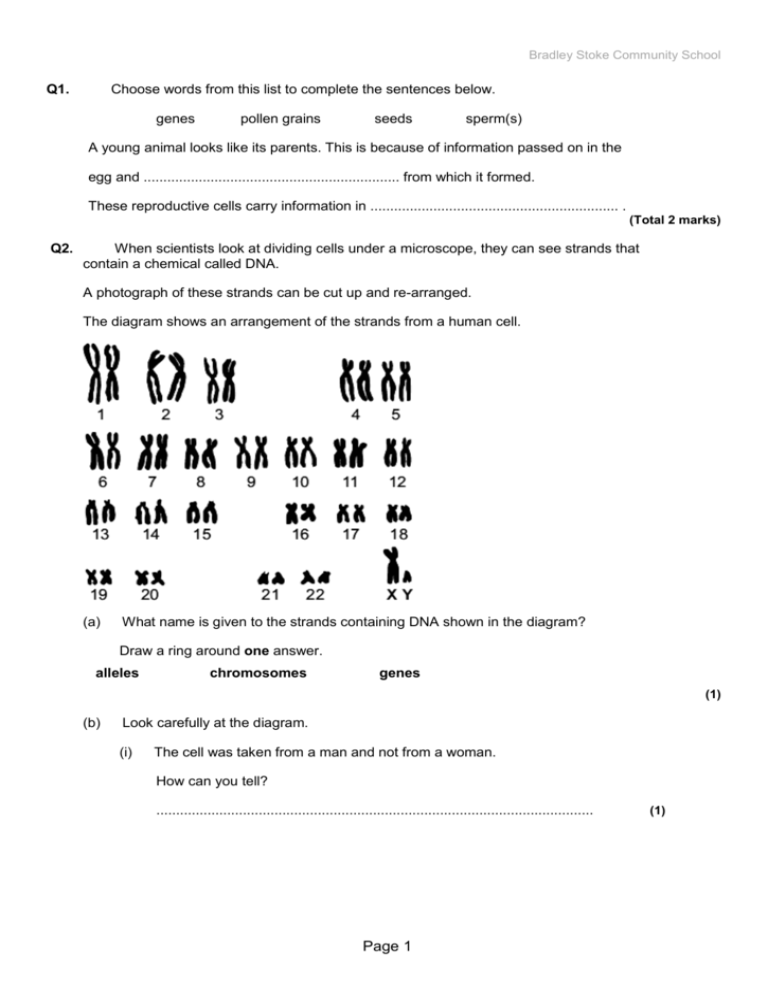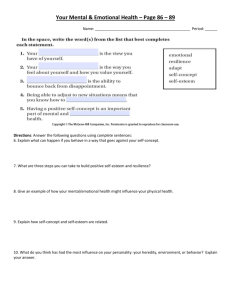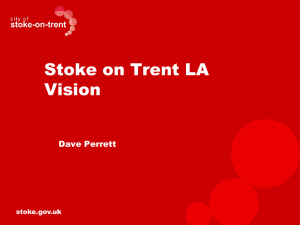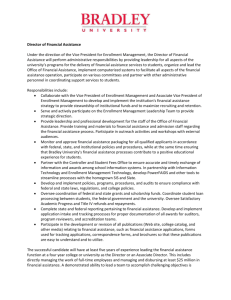File - Year 11 Revision
advertisement

Bradley Stoke Community School Q1. Choose words from this list to complete the sentences below. genes pollen grains seeds sperm(s) A young animal looks like its parents. This is because of information passed on in the egg and ................................................................. from which it formed. These reproductive cells carry information in ............................................................... . (Total 2 marks) Q2. When scientists look at dividing cells under a microscope, they can see strands that contain a chemical called DNA. A photograph of these strands can be cut up and re-arranged. The diagram shows an arrangement of the strands from a human cell. (a) What name is given to the strands containing DNA shown in the diagram? Draw a ring around one answer. alleles chromosomes genes (1) (b) Look carefully at the diagram. (i) The cell was taken from a man and not from a woman. How can you tell? ............................................................................................................... Page 1 (1) Bradley Stoke Community School (ii) What evidence is there that the strands are from a body cell, and not from a gamete? Tick ( ) one box. The strands are arranged in order of size. The strands are in pairs. Gametes are made in the testes and ovaries. (1) (iii) When a human cell is not dividing the strands containing DNA are not clearly visible. Draw a ring around the correct answer to complete the sentence. cell membrane. In a human cell, the DNA is normally found in the cytoplasm. nucleus. (1) (Total 4 marks) Q3. We breed animals with the characteristics that we prefer. (a) The photograph shows a rabbit with some of its babies. Photograph supplied by iStockphoto/Thinkstock Use words from the box to complete the sentences about inheritance in rabbits. characteristic chromosome gene gamete (i) The colour of a rabbit’s fur is known as a ............................................... (ii) This colour is controlled by a ................................................................. (1) (1) (iii) Each sex cell of a rabbit is known as a ................................................. (1) Page 2 Bradley Stoke Community School Q4. Humans reproduce sexually. Draw a ring around the correct answer to complete each sentence. (1) chromosomes (a) (i) At fertilisation genes join together. sex cells chromosomes. (ii) At fertilisation a single cell forms, which has new pairs of nuclei. sex cells. (b) Cystic fibrosis can be inherited by children whose parents do not have it. two (i)A person who has cystic fibrosis has three copies of the cystic fibrosis allele. four large. (ii)The cystic fibrosis allele is recessive. strong. (1) (c) The diagram shows a human body cell. Choose the correct answer from the box to complete each sentence. cell membrane (i) cell wall cytoplasm nucleus The part of the cell labelled B is the .............................................................. (1) (ii) The part of the cell labelled C is the .............................................................. (1) Page 3 Bradley Stoke Community School (d) Which part of the cell, A, B, C or D: (i) contains the allele for cystic fibrosis (1) (ii) is affected by cystic fibrosis? (1) (Total 8 marks) Q5. There are two types of reproduction, asexual and sexual. Use the words in the box to complete the sentences about reproduction. You may use each word once or not at all. asexual eggs gametes ovaries sexual sperms fertilisation testes inheritance variation The genetic information from the mother is carried in the ........................................ which are made in the ........................................ . The genetic information from the father is carried in the ........................................ which are made in the ........................................ . In ........................................ reproduction, offspring are produced that are genetically different from either parent. This happens because genetic information from each parent is carried in the ......................................... and joined together during ........................................ to develop into a fetus. In ........................................ reproduction, genetically identical offspring are produced because no mixing of genetic material takes place. (Total 8 marks) Page 4 Bradley Stoke Community School Q6. Maize plants reproduce sexually to form maize cobs. Each maize cob has many seeds. The colour of the seeds is controlled by a gene. The gene has two alleles, purple and yellow. The diagram shows the cobs produced by breeding maize plants. (a) Use words from the box to complete the sentences. dominant environmental (i) recessive The first generation plants show that the purple allele is .................................................................. (1) (ii) The second generation plants show that the yellow allele is .................................................................. (1) (b) The allele for purple can be represented by the letter A. The allele for yellow can be represented by the letter a. (i) What alleles does a yellow seed have? Draw a ring around one answer. AA Aa aa (1) (ii) What alleles does a purple seed from a first generation plant have? Draw a ring around one answer. AA Aa aa (1) Page 5 Bradley Stoke Community School (c) The drawing shows a cob from one of the second generation plants. A student counted 334 purple seeds and 110 yellow seeds on this maize cob. What is the approximate ratio of purple seeds to yellow seeds on the cob? Tick ( ) one box. 3 purple : 1 yellow 1 purple : 3 yellow 1 purple : 1 yellow (1) (Total 5 marks) Q7. Soay sheep live wild on an island off the north coast of Scotland. No people live on the island. Over the last 25 years, the average height and mass of the wild Soay sheep have decreased. The scientists think that climate change might have affected the size of the sheep. (a) More Soay sheep are now able to survive winter than 25 years ago. What change in the climate may have helped more Soay sheep to survive winters? ........................................................................................................................ ........................................................................................................................ Page 6 (1) Bradley Stoke Community School (b) Complete the sentences. (i) Soay sheep show variation in size because of differences in their ............................................................................ (ii) (1) The change in the size of the Soay sheep over 25 years can be explained by Darwin’s theory of ............................................................ (1) (Total 3 marks) Q8. The diagram shows the evolution of a group called the primates. (a) Which primate evolved first? ........................................................................................................................ (1) (b) Name two primates that developed most recently from the same common ancestor as humans. 1 ..................................................................................................................... 2 ..................................................................................................................... (2) (c) (i) The theory of evolution by natural selection was suggested in the 1800s. Which scientist suggested this theory? ............................................................................................................... (ii) (1) Use words from the box to complete the passage about natural selection. evolution environment generation mutate survive variation Individual organisms of a species may show a wide range of ................................... because of differences in their genes. Individuals with characteristics most suited to the ................................... are more likely to .................................. and breed successfully. The genes that have helped these individuals to survive are then passed on to the next .............................................................. (4) (Total 8 marks) Page 7 Bradley Stoke Community School People have different shaped ear lobes, either ‘hanging’ or ‘attached’. Q9. The diagrams show the two shapes of ear lobe. A gene controls the shape of a person’s ear lobes. The diagram shows a family tree. Parents A and B both have hanging ear lobes. (a) The key does not show the symbol for a female with attached ear lobes. Draw the symbol for the key to show a female with attached ear lobes. Use information in the family tree and the key. Symbol = ............................................................ (1) (b) Look at the family tree. What does the information in the family tree tell you about the allele for hanging ear lobes? Draw a ring around the correct word to complete the sentence. (1) dominant. The allele for hanging ear lobes is weak. recessive. (c) (i) Parents A and B have three children, C, D and E. All three children are boys. What are the chances that the next child of parents A and B will be a girl? Draw a ring around one answer. no chance (0 %) Page 8 a half (50 %) certain (100 %) Bradley Stoke Community School (ii) Which statement explains your answer to part (c)(i)? Tick ( ) one box. Some of B’s sperm cells have an X chromosome. Some of A’s egg cells have a Y chromosome. All of B’s sperm cells have an X chromosome. (1) (Total 4 marks) Q10. The family tree shows the inheritance of a disorder caused by a dominant allele. Fiona and Eric have two children George and Harriet. (a) The son, George, has the disorder. The daughter, Harriet, does not have the disorder. (i) Use the key to draw the symbol for Harriet next to her name on the family tree. (2) (ii) The symbol D represents the dominant allele for the disorder. The symbol d represents the recessive allele. Fiona has the pair of alleles dd. Write the correct pairs of alleles in the boxes. Harriet has the pair of alleles Page 9 Bradley Stoke Community School (b) Before Harriet was born, a doctor suggested that Fiona should have the embryo ‘screened’. (i) Give one reason why the doctor suggested screening. Tick ( ) one box. To check for the D allele To check the sex of the embryo To cure the disorder (1) (ii) Why do some people believe that embryos should not be screened? ............................................................................................................... ............................................................................................................... (1) (Total 7 marks) Q11. Animals have adaptations that enable them to survive. (a) The photograph shows an echidna. The echidna has pointed spines on its back. Explain how these spines might help the echidna to survive. ..................................................................................................................................... ..................................................................................................................................... ..................................................................................................................................... ..................................................................................................................................... (2) Page 10 Bradley Stoke Community School (b) The photograph shows a caterpillar. Explain how the caterpillar’s appearance might help it to survive. ..................................................................................................................................... ..................................................................................................................................... ..................................................................................................................................... ..................................................................................................................................... ..................................................................................................................................... (2) (c) Draw a ring around the correct answer to complete each sentence. genetic engineering (i) Evolution can be explained by a theory called mutation . natural selection (1) Darwin (ii) This theory was suggested by a scientist called Charles Lamarck . Semmelweiss (1) monkeys (iii) This scientist said that all living things have evolved from dinosaurs . simple life forms (1) (d) Many religious people oppose the theory of evolution. Give one reason why. Page 11 Bradley Stoke Community School ..................................................................................................................................... ..................................................................................................................................... (1) (Total 8 marks) Q12. The photographs show two varieties of moths, X and Y. The moths belong to the same species. The moths are resting on a tree trunk in open countryside. Moth X (a) Moth Y Which variety of moth, X or Y, is more likely to be killed by insect-eating birds? Give a reason for your answer. Variety of moth: ......................................................................................................... Reason ........................................................................................................................ .....................................................................................................................................(1) (b) In an experiment, large numbers of each variety of moth were caught in a trap. • They were marked with a spot of paint on the underside of one wing and then released. • A few days later, moths were again trapped and the number of marked moths was counted. • The experiment was carried out in a woodland polluted by smoke and soot, and also in an unpolluted woodland. The results are shown in the bar graph. (i) When the moths were being marked, suggest why the paint was put on the underside of the wing and not on the top. Page 12 Bradley Stoke Community School ........................................................................................................................... (1) (ii) What percentage of moths of type X was recaptured in: the polluted woodland; ..................................................................................... the unpolluted woodland? ................................................................................ (2) (iii) In each woodland, only a small number of marked moths of both varieties were recaptured. Suggest one reason for this. ........................................................................................................................... ........................................................................................................................... (1) (c) (i) The colour of the moths is controlled by a gene. The dark form was first produced by a mutation in the gene. What chemical, found in a gene, is changed by a mutation? Draw a ring around your answer. carbohydrate DNA fat protein (1) (ii) Some of the offspring from the original dark moth were also dark. What caused this? ........................................................................................................................... ........................................................................................................................... (1) (Total 7 marks) Q13. These young rabbits look like their parents. This is because information about characteristics such as fur colour is passed from parents to their young. Choose words from this list to complete the sentences below. body chromosomes genes nucleus clones cytoplasm sex Information is passed from parents to their young in ............................................ cells. Page 13 Bradley Stoke Community School Each characteristic, e.g. fur colour, is controlled by .............................................. . The structures which carry information for a large number of characteristics are called ................................................ . The part of the cell which contains these structures is called the .................................. . (Total 4 marks) Q14. The diagram shows a human cell and some of its contents. (a) Choose words from this list to label the diagrams. chromosome cytoplasm gene nucleus (3) (b) Choose words from this list to complete the sentence. a body cell an egg cell a gamete a sperm cell In the cell above, the chromosomes are found in pairs so this cell must be ......................................................... (1) (Total 4 marks) Q15. The diagram shows a human cell and some of its contents. (a) Choose words from this list to label the diagrams. chromosome cytoplasm gene nucleus (3) (b) Choose words from this list to complete the Page 14sentence. Bradley Stoke Community School a body cell an egg cell a gamete a sperm cell In the cell above, the chromosomes are found in pairs so this cell must be ......................................................... M1. (1) (Total 4 marks) sperms genes each for 1 mark [2] M2. (a) chromosomes 1 (b) (i) has XY / Y allow female would be XX / has no Y 1 (ii) The strands are in pairs 1 (iii) nucleus 1 [4] M3. (a) (i) characteristic 1 (ii) gene 1 (iii) gamete 1 [3] M4. (a) (i) sex cells 1 (ii) chromosomes 1 (b) (i) two 1 (ii) recessive 1 (c) (i) cell membrane allow membrane 1 (ii) cytoplasm 1 (d) (i) A 1 (ii) B 1 [8] M5. eggs Page 15 Bradley Stoke Community School accept gamete once 1 ovaries 1 sperms accept gamete once 1 testes 1 sexual 1 gametes allow egg and sperm once 1 fertilisation 1 asexual 1 [8] M6. (a) (i) dominant allow clear indication 1 (ii) recessive allow clear indication 1 (b) (i) aa extra ring drawn cancels the mark 1 (ii) Aa extra ring drawn cancels the mark 1 (c) 3 purple : 1 yellow extra box ticked cancels the mark 1 [5] M7. (a) warmer / dryer allow greenhouse effect / global warming ignore wind 1 (b) (i) genes / alleles / chromosomes / DNA / genetic material / genetics allow inheritance allow nutrition / food / metabolism / growth rate ignore environment 1 Page 16 Bradley Stoke Community School (ii) natural selection / evolution allow survival of the fittest 1 [3] M8. (a) lemur(s) 1 (b) gorilla(s) in either order 1 chimpanzee(s) accept chimps 1 (c) (i) (Charles) Darwin accept (Alfred) Wallace if first name given it must be correct 1 (ii) variation in this order 1 environment allow phonetic spellings 1 survive 1 generation 1 [8] M9. (a) the shape must be (roughly) circular and not shaded, for the mark accept the shape drawn in the key if it is not contradictory 1 (b) dominant 1 (c) (i) a half (50%) 1 (ii) Some of B’s sperm cells have an X chromosome 1 [4] M10. (a) (i) circle mark independently 1 unshaded could be in body of script 1 Page 17 Bradley Stoke Community School (ii) (Harriet) dd in first box 1 DD if another letter is chosen it must be used throughout and upper or lower case must be clear 1 Dd 1 (b) (i) to check for the D allele. 1 (ii) any one from: • may harm / kill foetus / embryo / baby / mother allow could affect the baby • immoral / unethical / religion ignore playing God ignore references to unnatural ignore wrong unqualified ignore expense / prejudice unqualified ignore lack of permission ignore results are unreliable 1 [7] M11. (a) protection / defence ignore insulation or rolls into a ball ignore camouflage 1 from predators / from being attacked / from being eaten 1 (b) looks like snake / looks scary 1 deters predators or has large eyes to spot predator or camouflage or warning colouration from predator or prey allow two separate adaptations for 2 marks 1 (c) (i) natural selection 1 (ii) Darwin 1 (iii) simple life forms Page 18 Bradley Stoke Community School 1 (d) believe that God created all organisms or humans there from the beginning 1 [8] M12. (a) X (no mark) X is more visible or Y is more camouflaged 1 (b) (i) so camouflage not changed or so not easier to see 1 (ii) 25 1 7 1 (iii) any one from: • eaten (by birds) / died • mixed in with large number of unmarked moths • moved away 1 (c) (i) DNA 1 (ii) the gene / allele for being dark / dominant 1 [7] Page 19 Bradley Stoke Community School M13. sex genes chromosomes nucleus in order for 1 mark each [4] M14. (a) (i) nucleus (ii) chromosome (iii) gene each for 1 mark 3 (b) a body cell for 1 mark 1 [4] M15. (a) (i) nucleus (ii) chromosome (iii) gene each for 1 mark 3 (b) a body cell for 1 mark 1 [4] Page 20







